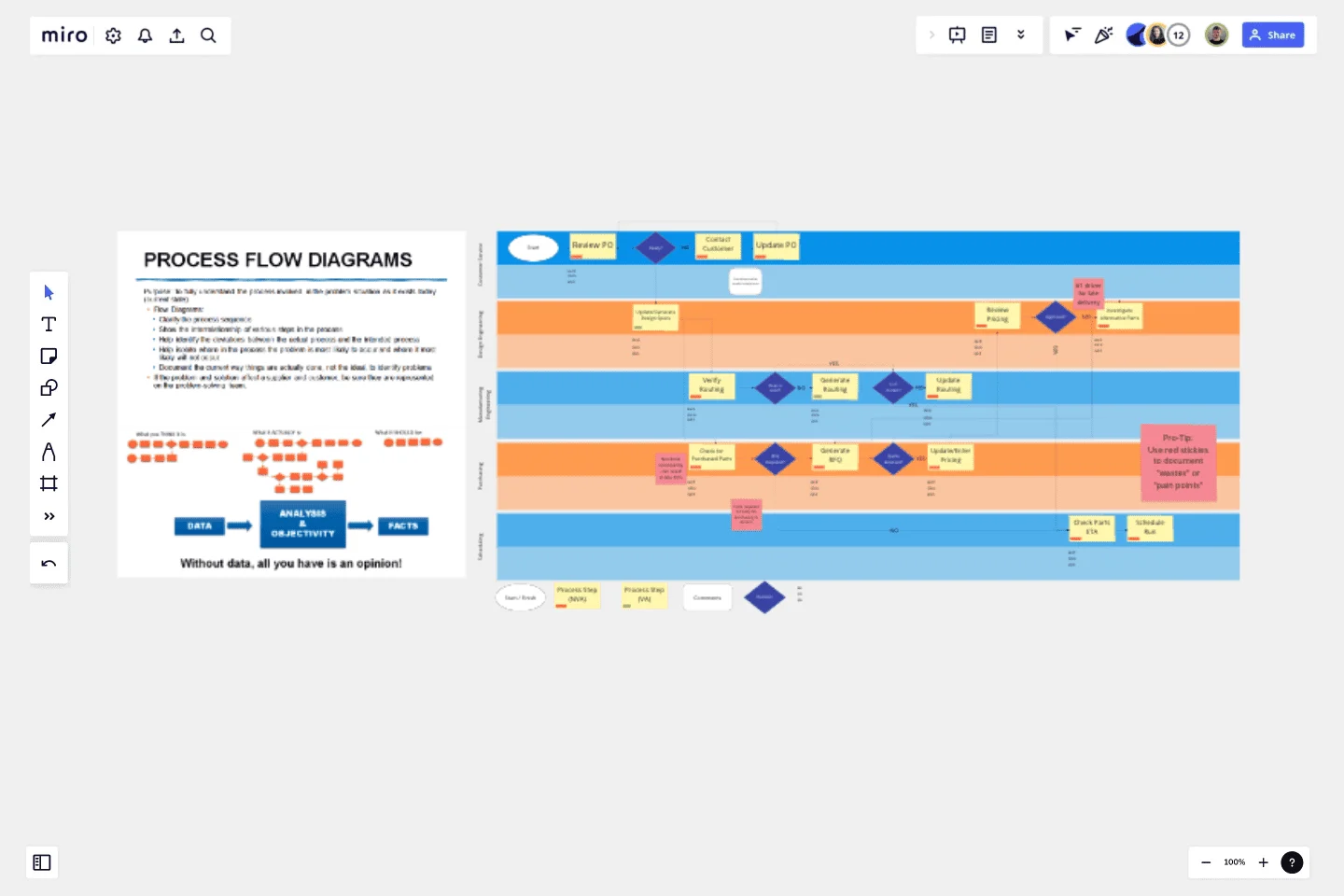Swim Lane Diagram with Data
This swim lane diagram is a fundamental tool to any transactional process improvement
This template allows you to visualize the process, understand the current state, and enables you to visualize a complex transactional process covering multiple roles and departments. The insights that you will gain while building this diagram as a team can be exceptionally meaningful.
This swim lane diagram will help you to:
Clarify the process sequence
Capture process relevant data
Show the interrelationship of various steps in the process
Help identify deviations between the actual process and the intended process
Help isolate where in the process the problems are most likely to occur
Visually demonstrate the number of hand-offs between roles and/or departments
When evaluating your process document the current way things are actually done, not the ideal, to identify problems. This is accomplished by going to the actual place where the work is done and observing the actual work while talking to the individuals who perform the tasks. Do not take for granted that you know what happens. It is always important to go and see.
This template was created by NEXT LEVEL Partners.
Get started with this template right now.
Data Flow Diagram Template
Works best for:
Flowcharts, Software Development, Diagrams
Any process can get pretty complex, especially when it has multiple components. Get a better grasp of your process through a data flow diagram (DFD). DFDs create a simple visual representation of all components in the flow of data and requirements in an entire system. They’re most often used by growth teams, data analysts, and product teams, and they’re created with one of three levels of complexity—0, 1, or 2. This template will help you easily build the best DFD for your process.
Empathy Map for Customer Support
Works best for:
Empathy Map
Enhance your customer support with the Empathy Map for Customer Support template. This tool helps you understand your customers' emotions, challenges, and motivations. By mapping these insights, you can improve your support strategies, tailor responses, and provide a more empathetic service experience. Ideal for support teams looking to boost customer satisfaction and loyalty through deeper understanding and empathy.
Salesforce Implementation Plan
Works best for:
Roadmap, Planning, Mapping
The Salesforce Implementation Plan template offers a structured framework for planning and executing Salesforce deployment projects. By outlining key milestones, tasks, and dependencies, teams can ensure a smooth transition to the Salesforce platform. This template facilitates collaboration between IT and business teams, ensuring that implementation efforts are aligned with strategic objectives and deliver value to stakeholders.
UML Sequence Registration Process Template
Works best for:
UML
The UML Sequence Registration Process Template helps visualize and document user registration processes. It enables the rapid creation of sequence diagrams, which are crucial for enhancing clarity and identifying potential issues early in the design phase. This template not only supports collaborative efforts through Miro's platform, facilitating real-time teamwork, but also ensures a comprehensive system design. Being part of a broader collection of UML diagram templates, it stands as a valuable asset for projects involving registration workflows, contributing to streamlined project execution and effective communication among team members.
UML Class Messaging System Template
Works best for:
UML
The UML Class Messaging System Template streamlines the process of designing and analyzing messaging systems. It allows users to visually map out the structure of a system by detailing classes, their attributes, operations, and the relationships among objects. This template is particularly useful for illustrating the functionality of a messaging system, including the management of text messages, conversation threads, user contacts, notifications, and channels. It offers a clear visual representation of how all these elements interact within the system, making it an invaluable resource for developers, designers, and stakeholders aiming to enhance communication and reduce errors in the development phase.
Work Breakdown Structure Template
Works best for:
Project Management, Mapping, Workflows
A work breakdown is a project management tool that lays out everything you must accomplish to complete a project. It organizes these tasks into multiple levels and displays each element graphically. Creating a work breakdown is a deliverable-based approach, meaning you’ll end up with a detailed project plan of the deliverables you must create to finish the job. Create a Work Breakdown Structure when you need to deconstruct your team's work into smaller, well-defined elements to make it more manageable.
